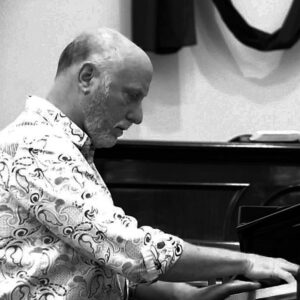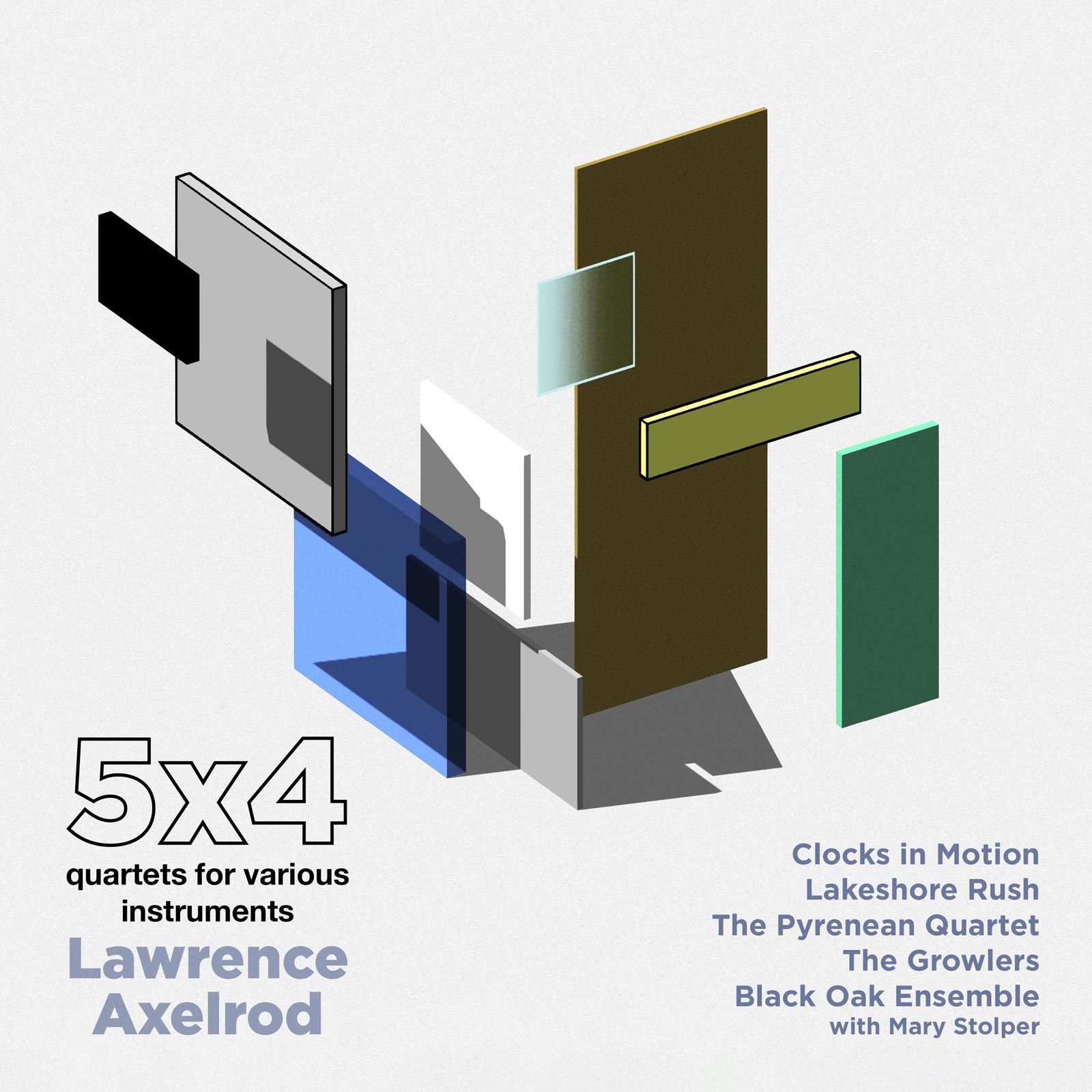5X4
Lawrence Axelrod composer
Clocks In Motion
Lakeshore Rush
The Pyrenean Quartet
The Growlers
Black Oak Ensemble | with Mary Stolper flute
At times meditative, at times sparklingly abstract, 5X4 is an album of contrasts. Composer Lawrence Axelrod offers a multi-faceted selection of original compositions which push the limits of musical craft – all contained within the quartet setup, but in varying instrumentations.
The range begins with the eternal classic, the string quartet, progresses to a less-orthodox quartet of flute, clarinet, violoncello, and piano, escalates to an otherworldly ensemble of percussion, and finally culminates with a hypnotic double bass quartet. Axelrod’s 5X4 is carefully conceptualized and altogether well-wrought; often contemplative, and always original.
Listen
Stream/Buy
Choose your platform
"A thoroughly engaging essay in sonority."
Track Listing & Credits
| # | Title | Composer | Performer | |
|---|---|---|---|---|
| 01 | An Opening, A Waltz, A Song, An Ending (2013) | Lawrence Axelrod | Black Oak Ensemble | Mary Stolper, flute; Desiree Ruhstrat, violin; Aurelien Pederzoli, viola; David Cunliffe, cello | 11:07 |
| 02 | Emeq (2015) | Lawrence Axelrod | Clocks in Motion | Sean Kleve, Megan Arms, Chris Jones, John Corkill - percussion | 12:23 |
| 03 | Chants and Antiphons (2020) | Lawrence Axelrod | The Pyrenean Quartet | Rika Seko, Kate Carter - violins; Claudia Lasareff-Mironoff, viola; Paula Kosower, cello | 11:19 |
| 04 | Punctuated! (2010): I. Asterisk | Lawrence Axelrod | Lakeshore Rush | Erin Murphy, flute; Laura McLaughlin, clarinet; Elena Doubovitskaya, piano; Christopher Ferrer, cello | 2:14 |
| 05 | Punctuated! (2010): II. Ellipsis | Lawrence Axelrod | Lakeshore Rush | Erin Murphy, flute; Laura McLaughlin, clarinet; Elena Doubovitskaya, piano; Christopher Ferrer, cello | 2:11 |
| 06 | Punctuated! (2010): III. Period | Lawrence Axelrod | Lakeshore Rush | Erin Murphy, flute; Laura McLaughlin, clarinet; Elena Doubovitskaya, piano; Christopher Ferrer, cello | 1:17 |
| 07 | Punctuated! (2010): IV. Question Mark | Lawrence Axelrod | Lakeshore Rush | Erin Murphy, flute; Laura McLaughlin, clarinet; Elena Doubovitskaya, piano; Christopher Ferrer, cello | 2:39 |
| 08 | Four Large Objects (2020) | Lawrence Axelrod | The Growlers | Douglas Johnson, Michael Hovnanian, Jonathan Cegys, Jeremy Attanasio - double basses | 10:02 |
Track 1 Recorded at Area44 Recordings in Northfield IL
Session Engineer Mat Prock
Track 2 Recorded at the University of Missouri/Columbia in Columbia MO
Session Engineer David Meyers
Track 3 Recorded at Experimental Sound Studio in Chicago IL
Session Engineer Ralph Loza
Track 4-7 Recorded at Pianoforte Studio in Chicago IL
Session Engineer Jeremy Whetstone
Track 8 Recorded at Experimental Sound Studio in Chicago IL
Session Engineer Ralph Loza
Mastering Melanie Montgomery
Executive Producer Bob Lord
A&R Director Brandon MacNeil
A&R Ivana Hauser
VP of Production Jan Košulič
Audio Director Lucas Paquette
VP, Design & Marketing Brett Picknell
Art Director Ryan Harrison
Design Edward A. Fleming
Publicity Aidan Curran
Artist Information

Lawrence Axelrod
A recent review in Opera News states that Lawrence Axelrod is “a … composer whose fresh and distinctive music deserves to be more widely known.” At once composer, pianist, and conductor, Axelrod’s musical activities have taken him around the United States, Europe, South Africa, Australia, and New Zealand. As a composer, Axelrod has had works performed by ~Nois Saxophone Quartet, the London Sylvan Ensemble, Quintet Attacca, The Chicago Composers Orchestra, Palomar, Ensemble Dal Niente, Pinotage, The Lincoln Trio, The Duo Ahlert/Schwab, and The Verdi String Quartet in recent seasons. Frissons was premiered by ~Nois on a concert devoted to new music for saxophone quartet in June 2019.

